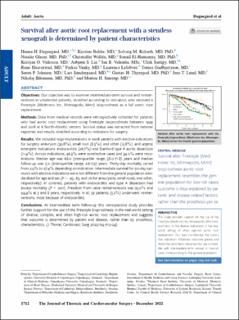Survival after aortic root replacement with a stentless xenograft is determined by patient characteristics
Dagnegård, Hanna H.; Bekke, Kirstine; Kolseth, Solveig Moss; Glaser, Natalie; Wallén, Christoffer; El-Hamamsy, Ismail; Vidisson, Kristjan O.; Lie, Asbjørn Sigstad; Valentin, Jan; Sartipy, Ulrik; Haaverstad, Rune; Vanky, Farkas; Lefebvre, Laurence; Gudbjartsson, Tomas; Johnsen, Søren P.; Søndergaard, Lars; Thyregod, Gustav H.; Lund, Jens T.; Ihlemann, Nikolaj; Smerup, Morten H.
Journal article, Peer reviewed
Published version

Åpne
Permanent lenke
https://hdl.handle.net/11250/3038892Utgivelsesdato
2021Metadata
Vis full innførselSamlinger
- Department of Clinical Science [2318]
- Registrations from Cristin [9791]
Originalversjon
Journal of Thoracic and Cardiovascular Surgery. 2022, 164 (6), 1712-1724.e10. 10.1016/j.jtcvs.2021.07.011Sammendrag
Objectives
Our objective was to examine intermediate-term survival and reinterventions in unselected patients, stratified according to indication, who received a Freestyle (Medtronic Inc, Minneapolis, Minn) bioprosthesis as a full aortic root replacement.
Methods
Data from medical records were retrospectively collected for patients who had aortic root replacement using Freestyle bioprostheses between 1999 and 2018 at 6 North-Atlantic centers. Survival status was extracted from national registries and results stratified according to indication for surgery.
Results
We included 1030 implantations in 1008 patients with elective indications for surgery: aneurysm (39.8%), small root (8.3%), and other (13.8%), and urgent/emergent indications: endocarditis (26.7%) and Stanford type A aortic dissection (11.4%). Across indications, 46.3% were nonelective cases and 34.0% were reoperations. Median age was 66.0 (interquartile range, 58.0-71.8) years and median follow-up was 5.0 (interquartile range, 2.6-7.9) years. Thirty-day mortality varied from 2.9% to 27.4% depending on indication. Intermediate survival for 90-day survivors with elective indications were not different from the general population standardized for age and sex (P = .95, .83, and .16 for aneurysms, small roots, and other, respectively). In contrast, patients with endocarditis and type A dissection had excess mortality (P < .001). Freedom from valve reinterventions was 95.0% and 94.4% at 5 and 8 years, respectively. In all, 52 patients (5.2%) underwent reinterventions, most because of endocarditis.
Conclusions
At intermediate term follow-up this retrospective study provides further support for the use of the Freestyle bioprosthesis in the real-world setting of diverse, complex, and often high-risk aortic root replacement and suggests that outcome is determined by patient and disease, rather than by prosthesis, characteristics.
